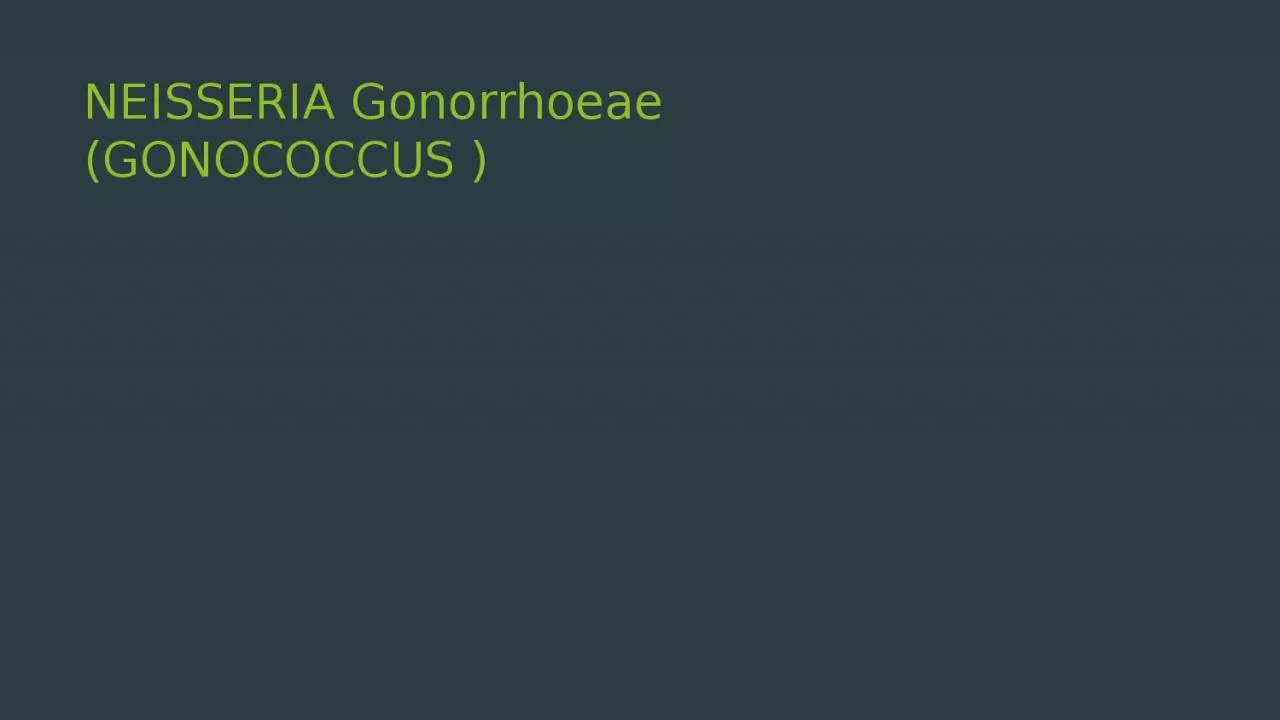

Virulence Factors Pili or fimbriae Adhesion to host cells amp prevent phagocytosis Outer membrane proteins Porin protein I gt50 of OMP PorB1A strains local and disseminated ID: 1014936
Download Presentation The PPT/PDF document "NEISSERIA Gonorrhoeae (GONOCOCCUS )" is the property of its rightful owner. Permission is granted to download and print the materials on this web site for personal, non-commercial use only, and to display it on your personal computer provided you do not modify the materials and that you retain all copyright notices contained in the materials. By downloading content from our website, you accept the terms of this agreement.
1. NEISSERIA Gonorrhoeae (GONOCOCCUS )
2. Virulence FactorsPili or fimbriae - Adhesion to host cells & prevent phagocytosisOuter membrane proteins – - Porin (protein I) - >50% of OMP- PorB.1A strains - local and disseminated gonococcal infections - PorB.1B strains- local genital infections only
3. Virulence FactorsOpacity-associated protein (Protein II) - adhesion to neutrophils & other gonococciTransferrin-binding and lactoferrin-binding proteinsIgA1 protease - protection from mucosal IgALipo-oligosaccharide (LOS) - endotoxic activity.
4. Clinical ManifestationsGonorrhea Males: Acute urethritis MC manifestation Purulent urethral discharge ( ‘gonorrhea’- flow of seed)Incubation period is 2–7 daysComplications - epididymitis, prostatitis, balanitis & water-can perineum
5. Clinical ManifestationsFemalesInfection is less severe – More asymptomatic carriage than males Mucopurulent cervicitis - MC presentationVulvovaginitis – in prepubertal girls & postmenopausal women- vagina mucosa thinned out & higher pHNot in adult females - resistant to gonococcal infection (low pH and thick stratified squamous epithelium)
6. Clinical ManifestationsSpread - Bartholin’s gland, endometrium and fallopian tube. Salpingitis and pelvic inflammatory disease sterilityFitz–Hugh–Curtis syndrome – rare - peritonitis & perihepatic inflammation.Both the sexes Anorectal gonorrhea Pharyngeal gonorrheaOcular gonorrhea
7. Clinical ManifestationsPregnant womenprolonged rupture of the membranes, premature delivery, chorioamnionitis, and sepsis in the infantNeonates (Ophthalmia neonatorum)- colonized maternal genital flora- Purulent eye discharge within 2–5 days of birth
8. Clinical ManifestationsDisseminated gonococcal infection (DGI)Rarely following gonococcal bacteremiaPolyarthritis and rarely dermatitis & endocarditis In HIV-infected persons- Nonulcerative gonorrhea
9. EpidemiologyIncidence decreased indeveloped countriesUnder reporting due to stigmaHost - exclusively human diseaseSource - asymptomatic female carriers or less often patientTransmissionsexual contact (venereal)Mother to baby during birth.
10. Laboratory DiagnosisSpecimen Collection- Urethral swab in men and cervical swab in women- Dacron or rayon swabsIn chronic urethritis secretion after prostatic massage or morning drop of secretionTransport Media - Charcoal-coated swabs kept in Stuart’s transport medium , Amies medium, JEMBEC or Gono-Pak system
11. Laboratory DiagnosisMicroscopy- Gram-negative intracellular kidney-shaped diplococci- 50% sensitive
12. Laboratory DiagnosisCulture-Endocervical culture has a sensitivity of 80–90%- Cervical swabs contain normal flora - selective media preferred (Inhibit commensal Neisseria)Thayer Martin medium - Chocolate agar with vancomycin, colistin and nystatinModified New York City medium - Lysed blood agar and lincomycin, colistin, trimethoprim and amphotericin BMartin–Lewis medium.
13. Laboratory DiagnosisBiochemical Tests- To differentiate gonococci from other commensal Neisseria speciesGonococci are catalase and oxidase positiveFerment only glucose, but not maltose and sucrose.
14. Nongonococcal (Nonspecific) urethritis Chronic urethritis where gonococci cannot be demonstratedNGU is more common than gonococcal urethritis. Bacteria:- Chlamydia trachomatis: Most common agentUreaplasma urealyticum, Mycoplasma hominisGonococcal infection, cocci in L forms Viruses: Herpes simplex virus & Cytomegalovirus Fungi - Candida albicans Parasites - Trichomonas vaginalis
15. ReferencesTextbook of Medical Microbiology by Ananthnarayan, PanikerTextbook of Medical Microbiology by C.P Baweja Textbook of Medical Microbiology by S. Bhat, A.S.SastryTextbook of Medical Microbiology by D.R.Arora, Brij bala Arora